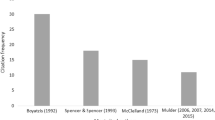Abstract
Institutes imparting training in marine engineering require replication of shipboard ambience for strengthening the competencies. For building an engineering centre for training, five options at different physical levels were considered based on a model of a new liquefied natural gas tanker ship build. A mock-up facility, simulator, full-scale engine room, scaled down version and a combination arrangement with live and dummy equipment were the options. Analytic hierarchy process was applied for selecting a suitable option based on criteria of cost, effectiveness in attaining competencies, practicability and environmental conduciveness. Analyses were carried out on the eigenvalues based on eight subselection criteria. The combination of live equipment (boilers and turbo alternator) and non-live shipboard equipment (auxiliaries) was chosen based on the global weightages obtained from the pairwise comparison matrix computations. The reliability was ascertained from the consistency index which was less than 0.1. For selection of the learning modes and the equipment, a constructivist approach of learners reflecting and choosing the learning mode was adopted. Industry practitioners were made into learner groups composed of trainers, shipboard personnel and company personnel. Established competencies were assigned as scores to the different learning modes. ANOVA application and statistical methods were used to analyse the scores to verify if there were too much variation in the choices. The calculated F ratio values were low (0.14 to 0.40) compared to the reference values indicating that the choices were even. The chi-squared test indicated that the group composition did have an influence on choosing the learning mode and equipment for training. The objective of identifying the learning mode and equipment for the training centre was achieved.





Similar content being viewed by others
References
Aly N, Akpovi J (2001) Total quality management in California public higher education. Qual Assur Educ 9(3):127–131
Bhardwaj S (2013) Technology and the up-skilling or deskilling conundrum. WMU J Marit Aff 12(2):245–253. doi:10.1007/s13437-013-0045-6
Bhardwaj S, Pazaver A (2016) Establishing the underpinning theories of maritime education and training for on-board competencies. IIRE Publications: ISFIRE Working paper Series 1:1–18
Brooks JG, Brooks MG (1993) In search of understanding: the case for constructivist classrooms. Association for supervision and curriculum development, Alexandria, pp 60–68
Brown JS, Collins A, Duguid S (1989) Situated cognition and the culture of learning. Educ Res 18(1):32–42
Caldwell S (2010) Statistics unplugged, Third edn. Cengage Learning, California: Wadsworth
Collins, A., Brown, J.S. and Newman, S.E. (1989). Cognitive apprenticeship: teaching the crafts of reading, writing and mathematics. In L.B. Resnick (Ed.) Knowing, Learning and Instruction: Essays in Honor of Robert Glaser. Hillsdale, New Jersey: Lawrence Erlbaum Associates. Pp. 453–494
Dong Y, Zhang G, Hong WC, Xu Y (2010) Consensus models for AHP group decision making under row geometric mean prioritisation method. Decis Support Syst 49(3):281–289
Driscoll, M.P. (2007). Psychological foundations of instructional design. In R.A. Reiser (Ed.). Trends and issues in instructional design and technology. 2nd Edition. New Jersey: Pearson Education Inc. Pp.36–44
Ertmer PA, Newby TJ (1993) Behaviourism, cognitivism, constructivism: comparing critical features from an instructional design perspective. Perform Improv Q 6(4):50–72
Harvey L, Green D (1993) Defining quality. Assessment and Evaluation in Higher Education 18(1):9–34
Honebein, P. (1996). Seven goals for the design of constructivist learning environments. In B. Wilson (Ed.) Constructivist learning environments. New Jersey: Educational Technology Publications. Pp.17–24
Jadhav AS, Sonar RM (2009) Evaluating and selecting software packages: a review. Inf Softw Technol 51(3):555–563
Jonassen DH (1991) Objectivism versus constructivism: do we need a new philosophical paradigm? Educ Technol Res Dev 39(3):5–14
Jonassen DH (1994) Thinking technology. Educ Technol 34(4):34–37
Kanji GK, Malek A, Tambi A (1999) Total quality management in UK higher education institutions. Total Qual Manag 10(1):129–153
Middlehurst R (1992) Quality: an organising principle for higher education. High Educ Q 46(1):20–38
Neuman WL (2003) Social research methods—qualitative and quantitative approaches, 5th edn. Pearson Education Inc. Allyn and Bacon, Boston, pp 438–467
Parasuraman A, Zeithaml VA, Berry LL (1988) SERVQUAL: multiple item scale for measuring consumer perceptions of services quality. J Retail 64(1):12–40
Saaty TL (1980) The analytic hierarchy process. McGraw Hill, New York
Saaty TL (2000) Fundamentals of decision making and priority theory with the analytic hierarchy process. RWS Publications, Pittsburgh
Saaty TL (2005) Theory and application of analytic network process. Decision making with benefits, opportunities, costs and risks. RWS Publications, Pittsburgh
STCW (1978). Standards of Training, Certification and Watchkeeping for Seafarers 1978 and code (as amended in The Manila amendments to the STCW, 1978 of 2010)
Tam M (2000) Constructivism, instructional design and technology: implications for transforming distance learning. Educational Technology & Society 3(2)
Tsinidou M, Geroghiannis V, Fytsilis P (2010) Evaluation of the factors that determine quality in higher education: an empirical study. Qual Assur Educ 18(3):227–244
Vrasidas C (2000) Constructivism versus objectivism: implications for interaction, course design and evaluation in distance education. Int J Educ Telecommun 6(4):339–362
Vroeijenstijn, T. (1992). External quality assessment, servant of two masters? The Netherlands University perspective, Proceedings of International Conference 1991, Hong Kong, The Falmer Press, London. pp. 109–131
Wilson B, Cole P (1991) A review of cognitive teaching models. Educ Technol Res Dev 39(4):47–64
Acknowledgments
We thank Mr. David Fredrick CEO, Malaysian Maritime Academy, for the project support and Captain Dr. Manivannan Subramaniam for the contribution towards the survey on the METIs. We wish to thank MISC Berhad for providing the Crew Competency Management (CCM) matrix and participating in the workshops.
Author information
Authors and Affiliations
Corresponding author
Appendices
Appendix 1
Appendix 2
Appendix 3
Rights and permissions
About this article
Cite this article
Balaji, R., Venkadasalam, S. Developing a marine engineering centre of excellence for competency-based training. WMU J Marit Affairs 16, 293–311 (2017). https://doi.org/10.1007/s13437-017-0124-1
Received:
Accepted:
Published:
Issue Date:
DOI: https://doi.org/10.1007/s13437-017-0124-1




